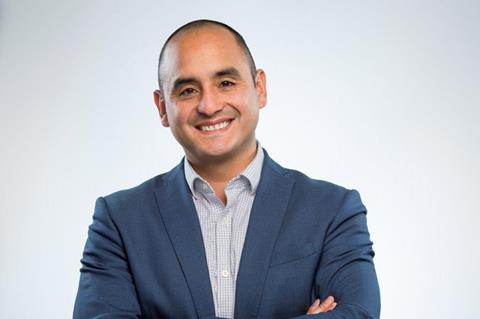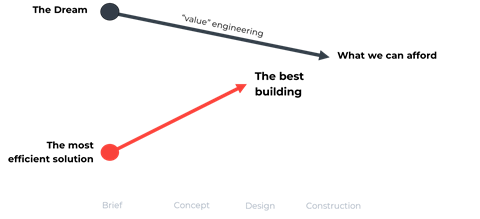Artificial intelligence is enabling us to design and build the optimal building from the outset, says Diego Padilla-Philipps. This means we can add value, improve performance and reduce the cost

Generative AI is, at its simplest, a series of algorithms and models designed to generate new content, images, text, audio. These models can produce original outputs based on patterns and structures trained on large datasets.
The ways in which it can be used are vast, from graphic design, social media, content creation, predictive text-to-videos, code generation, and even drug discovery.
>> Also read: The stakes are high but so are the rewards: AI and the future of construction
Generative modelling, a subset of machine learning, trains programs to create new data resembling an existing dataset. Unlike traditional machine learning, which focuses on predictions – such as determining if a painting is by Van Gogh – generative AI can create a painting in Van Gogh’s style from scratch.
Until recently, such feats were deemed impossible, as creativity was thought to be uniquely human. Yet, as machine learning technology has progressed, this view is changing.
Generative AI is used to create building models, then test them, and predict their behaviour, following an evidence-based process that leads to better buildings
In engineering and architecture, we are already combining AI’s computational and predictive power to analyse a large number of design iterations to optimise material use, energy consumption and reduce waste. ��ɫ����TV models and simulations prove incredibly useful; they help us to understand behaviour under real-world conditions during the building’s lifecycle.
And this is only the beginning. Performance-driven, evidence-based design is transforming how we understand buildings. We are now able to test and analyse thousands of designs in a matter of hours, incorporating this data into the decision-making process, enhancing our perception, intuition and creativity.
Generative AI is much more than creating beautiful images or videos from a text description. It is more than using enhanced web search or writing an essay. Generative AI is used to create building models, then test them, and predict their behaviour, following an evidence-based process that leads to better buildings.
The status quo
The current design process is linear, unidirectional, deterministic and with very few iterations. Each discipline (architecture, structures, MEP) introduces principles and constraints in response to the previous stage. Only a few options are tested, and new solutions are proposed, which feed back and inform the next step.
However, this is inherently slow, but more importantly full of bias, as the order in which the constraints are proposed can significantly determine the final outcome. Decisions that were introduced at the early stages become the DNA of the building, seriously limiting the scope for optimisation. And, since early-stage fees are small, we really miss the opportunity to achieve better buildings because there simply are not enough resources available.
The current design paradigm can be oversimplified to a process where we start with “the dream” brief and then we spend the rest of the design process … de-specifying the project until we reach what we can afford
The current design paradigm can be oversimplified to a process where we start with “the dream” brief (which is typically the most carbon intensive solution, and the most expensive), and then we spend the rest of the design process “value-engineering” it; or better said: de-specifying the project until we reach what we can afford.
This process is inherently negative and frustrating for all stakeholders. But, more importantly, it is limited by those initial constraints and assumptions, which narrow the scope for improvement.

A new paradigm
Evidence-based design and AI can help us to flip this around. Using multi-objective-optimisation (or multi-disciplinary-optimisation), we can test hundreds of variables, across thousands of iterations, and assess many KPIs simultaneously. This genuine (almost unconstrained) optimisation enables a broad, clear-eyed view of what good looks like at the start of a project – when it matters the most – leading to the most efficient solution possible. We can then follow this by increasing value through conscious and informed decisions until we reach the best possible product.
This combination of evidence-based techniques and regeneration principles, powered by AI, is what we call evidence-based, human-centred augmented-intelligence, and it is essential to create better buildings that go beyond sustainability.

At WSP we are turning this into our design philosophy and embedding it into every project. , uses bespoke parametric building models that include engineering criteria, combined with architectural requirements, to test the performance of thousands of models created using a genetic algorithm. With this data, multiple objectives can be assessed simultaneously: building embodied carbon, energy use, facade performance, overheating potential, daylight, shading, user comfort, and soon biodiversity, cost, and more.
This helps us to understand the mutual consequences of some decisions and the trade-offs needed to achieve the desired outcome.
Thousands of solutions are presented in a customisable design space. The parameters can be filtered using a parallel coordinates plot to narrow the results to select those that best meet the brief.
AI is allowing us to completely flip the current paradigm of design upside down: enabling early-stage optioneering using multiple parameters and multiple objectives to truly optimise buildings from the outset; providing evidence to inform every step of the design process and allowing us to really drive carbon emissions down.
We are redefining “value engineering” as a process of adding value, improving performance and creating better buildings… not just reducing cost.
Diego Padilla-Philipps is director of decarbonisation and innovation for building structures at WSP. This is the second of three columns about the growth of AI in the construction sector and what property professionals can expect to see in the future


























No comments yet